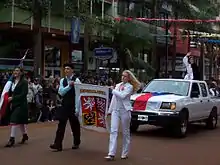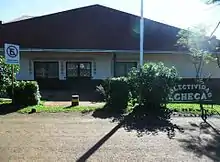 | |
| Total population | |
| 40,000 | |
| Regions with significant populations | |
| Buenos Aires · Santa Fe · Chaco · Misiones | |
| Languages | |
| Spanish · Czech | |
| Religion | |
| Christianity · Judaism · Others | |
| Related ethnic groups | |
| Czechs · Other Argentines |
Czech immigration to Argentina began during the World War I and was divided in four periods. It is estimated that around 40,000 Czechs arrived in Argentina between then and 1970. Argentina has the largest Czech community in Latin America. Czechs settled mainly in Buenos Aires, Gran La Plata, Rosario and Chaco.[1]
Immigration Waves

There are four waves Czech immigration periods to Argentina recognized as substantial. The first was slightly before World War 1, the second from 1920 to 1930, the third during World War II and the fourth, the smallest in proportion, during 1990 (after the fall of communism in Eastern Europe). During the first two periods, the immigration group was mainly made up of workers and farmers motivated by economic reasons. During the third period, Czech political exiles arrived, fled mainly due to the Nazi encroachment in Central Europe. The smallest fourth immigration period is formed by different social classes and their immigration reasons are related to economic reasons and personal interests.
The largest community of Czech descendants in Argentina is found in the city of Saénz Peña, province of Chaco. According to research, its origins date back to 1913, with the arrival of immigrants Juan Novotny and Pedro Šašvata to the city.[2][3] Over the decades, the Czech community founded a cooperative, two sports clubs and other associations in which you can still learn Czech and typical dances.[4]
See also
References
- ↑ "Čeští krajané v Argentině - historie a současnost" (in Czech). Velvyslanectví České republiky v Buenos Aires. 11 October 2009. Retrieved 12 January 2014.
- ↑ Bergallo, Elizabeth. "Checoslovacos en Presidencia Roque Saénz Peña".
- ↑ "Se cumple un siglo de los primeros colonos checos en el Chaco argentino". Radio Prague International (in Spanish). 2013-04-22. Retrieved 2021-03-08.
- ↑ "Checos y eslovacos, descendientes que preservan la cultura del Viejo Mundo" Diario Norte, 25/10/2010